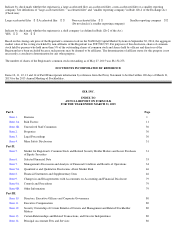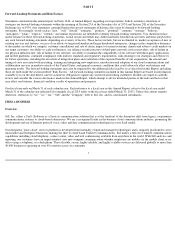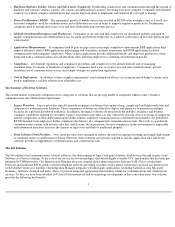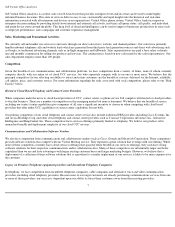8x8 2015 Annual Report Download - page 13
Download and view the complete annual report
Please find page 13 of the 2015 8x8 annual report below. You can navigate through the pages in the report by either clicking on the pages listed below, or by using the keyword search tool below to find specific information within the annual report.
Research and Development
The UCC in the cloud market is characterized by rapid technological changes and advancements, typical of most SaaS markets. Accordingly, we
make substantial investments in the design and development of new products and services, as well as the development of enhancements and
features to our existing products and services, and make these enhancements available to our customers frequently. Our future development
programs also will focus on the integration and functionality of our products and services with other SaaS products, such as Salesforce.com,
Netsuite, Zendesk and others. Supporting a variety of standard and custom integration partners and services is essential to our success as a cloud
services provider.
We currently employ more than 140 individuals in research, development and engineering activities in our facilities in San Jose, California as
well as outsourced software development consultants. Research and development expenses in each of the fiscal years ended March 31, 2015,
2014 and 2013 were $15.1 million, $11.6 million and $8.1 million, respectively.
Regulatory Matters
VoIP and other communications and collaboration services, like ours, have been subject to less regulation at the state and federal levels than
traditional telecommunications services. Providers of traditional telecommunications services are subject to the highest degree of regulation,
while providers of VoIP and other information services are largely exempt from most federal and state regulations governing traditional common
carriers. The FCC has subjected VoIP service providers to a smaller subset of regulations that apply to traditional telecommunications service
providers and has not yet classified VoIP services as either telecommunications or information. The FCC is currently examining the status of
VoIP service providers and the services they provide in multiple open proceedings. In addition, many state regulatory agencies impose taxes and
other surcharges on VoIP services, and certain states take the position that offerings by VoIP providers are intrastate telecommunications
services and therefore subject to state regulation. These states argue that if the beginning and end points of communications are known, and if
some of these communications occur entirely within the boundaries of a state, the state can regulate that offering. We believe that the FCC has
preempted states from regulating VoIP offerings in the same manner as providers of traditional telecommunications services. However, this issue
has not been resolved definitively as a matter of law, and it remains possible that the FCC could determine that such services are not information
services, or that there could be a judicial or legislative determination that the states are not preempted from regulating VoIP services as
traditional telecommunications services. We cannot predict how or when these issues will be resolved or its potential future impact on our
business at this time.
The effect of any future laws, regulations and orders on our operations, including, but not limited to, our cloud-based communications and
collaboration services, cannot be determined. But as a general matter, increased regulation and the imposition of additional funding obligations
increases service costs that may or may not be recoverable from our customers, which could result in making our services less competitive with
traditional telecommunications services if we increase our prices or decreasing our profit margins if we attempt to absorb such costs.
In addition to regulations addressing Internet telephony and broadband services, other regulatory issues relating to the Internet, in general, could
affect our ability to provide our services. Congress has adopted legislation that regulates certain aspects of the Internet including online content,
user privacy, taxation, liability for third party activities and jurisdiction. In addition, a number of initiatives pending in Congress and state
legislatures would prohibit or restrict advertising or sale of certain products and services on the Internet, which may have the effect of raising the
cost of doing business on the Internet generally.
Federal, state, local and foreign governmental organizations are considering other legislative and regulatory proposals that would regulate and/or
tax applications running over the Internet. We cannot predict whether new taxes will be imposed on our services, and depending on the type of
taxes imposed, whether and how our services would be affected thereafter. Increased regulation of the Internet may decrease its growth and
hinder technological development, which may negatively impact the cost of doing business via the Internet or otherwise materially adversely
affect our business, financial condition and results of operations. Please refer to Part I, Item 1A. "Risk Factors" for a discussion of regulatory
risks, proceedings and issues that could adversely affect our business and operating results in the future.
Intellectual Property and Proprietary Rights
Our ability to compete depends, in part, on our ability to obtain and enforce intellectual property protection for our technology in the United
States and internationally. We currently rely primarily on a combination of trade secrets, patents, copyrights, trademarks and licenses to protect
our intellectually property. As of March 31, 2015, we have been awarded 104 United States patents, of which we expect to expire between 2015
and 2042. We have additional United States and foreign patent pending.
9
























